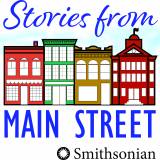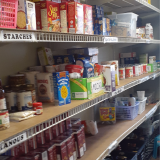The Way We Worked in Brunswick, Maryland
Story Narrative:
Residents recall what Brunswick was like when most people worked for the railroad and it was a bustling community. Now, the town is largely inhabited by commuters and there are few local businesses. This film explores how things have changed and what it's like today. Created by students in conjunction with the Brunswick branch of the Frederick County Public Library in partnership with the Brunswick Heritage Museum.
Jeff Snoots (00:15): Current work and businesses in Brunswick today is a lot different than it was in my day, as growing up, as a youth in Brunswick. Potomac Street was bustling with stores and all kinds of stores, grocery stores, a five and dime, a dry cleaners, restaurants. Today it's different, if you look. Our downtown's struggling to make a comeback, but back then, people that lived in Brunswick, pretty much worked on the railroad. Now, that's different. People who live in Brunswick pretty much work in DC and commute on the train. So, it's a lot different today than it was when I was growing up.
Tom Watson (00:52): Everybody who lived here, worked here. It wasn't a commuter community.
Christine Spielman (01:01): My grandfather worked on the railroad and retired from the railroad, here locally. My grandmother, in the late '30s worked at Schnauffer's Hospital, which was on B Street, originally in Brunswick, as a nurse.
Lester Pearrell (01:17): I worked at SuperFresh for about 18 years, as a meat manager. My mom worked there for 10 years in the deli and my dad actually worked on a railroad for 28 years as a foreman on the railroad, as supervised electricians.
Jim Castle (01:35): My great-grandfather worked on the railroad, my grandfather and my father, a short period of time. But, I did not work on the railroad as there was no railroad jobs, when I was, became of working age.
Jeff Snoots (01:50): My family goes way back in work history in Brunswick. It starts back to my great-great-grandfather. When he was, I think ,om said 14, 15. He would walk down to the canal from Dargan before he moved to Brunswick. He would guide the mules, pulling the canal boats.
Bruce Funk (02:08): My grandfather was a carpenter, by trade. He was a building contractor and he built a lot of the buildings here. He built the Red Men's, where the museum is. He built the Kaplon Building. He built the first brick Methodist Church, the Catholic Church, the Baptist Church, the Lutheran Church, the Jewish Synagogue, and a whole lot of homes up on New York Hill.
Jeanette Cincotta (02:32): My husband's father came here in probably 1914 or '16, and he was in the wholesale fruit business.
Savanna Moler (02:42): My grandfather, Glen Richard Moler, worked at the Baltimore and Ohio YMCA as an Executive Director. He worked at YMCA on Potomac street until 1980, when the YMCA burned, because of electrical short.
Earl Strine (02:59): My grandfather lived here on West G street from 1910 to about 1975, was a builder. So, he built a lot of the homes here in Brunswick. Then when he retired or through the course of I think, the 1940s and '50s, he did, was like one of the first trashman here, on West G Street, here in Brunswick.
Karen Hoffman (03:21): My sister worked for Price Electric in Frederick. I worked at Meguesta Mills in Brunswick, as a sewing factory. My brother worked for the Park Service.
Peter Wenner (03:32): Well, my family had a very long working history in Brunswick. My great-great grandfather, Charles Fenton Wenner, had a 500-acre farm that ran the length of the Maple Avenue Hill. He owned a flour mill on the C&O Canal. The history has it, that that mill was in the Wenner family, going back as far as 1795.
Tom Watson (03:58): My father owned the store that's behind us. Watson's Cut Rat,. And he had that until 1962. He sold it in 1962 and he went to work for the Post Office and he carried mail for the Post Office until 1973.
Julie Maynard (04:15): Basically, I think if you talk to the older people in town, they'll all want to tell you the story about how Saturday night in Brunswick, the crowds were so thick that you couldn't walk on the sidewalks. They had to get off and walk in the streets.
Jeff Snoots (04:32): When I was your age, 11 and 12 years old, it was hustle- bustle in Brunswick. Friday night, you couldn't find a place to park.
Tom Watson (04:40): I can remember, as a teenager, in the late 1950s, that on Saturday night, you couldn't walk up and down Potomac street, there were so many people going up and down the street. I didn't go to Frederick for anything until I was 19 years old. Everything was available here in Brunswick. We had Kaplon's over there, for all your clothing. The Potomac Edison had a store where you bought all your appliances. J.P. Karns was right down the hill, where there's a lumber company and hardware store. Everything that you wanted was available here in Brunswick.
Jim Castle (05:19): I've enjoyed many years of talking to older residents. Unfortunately, a lot of those folks are no longer with us now, and my memory just always goes back to the fond thoughts that they, their fond memories they always had of this downtown, of the stores that they visited, of railroad payroll, of the gentlemen who worked in the dime store right next door, and that business was so brisk on a Friday night that he used to have to go make a deposit two times during the night, because they had so much money.
Julie Maynard (05:59): People tended to go into town on Saturday night, come in from the country and spend their paychecks. Often in Brunswick that was added by the fact, I think, often the payroll came once a month and people had this giant amount of money to go out and spend, and they did. So, everybody came into town to celebrate and meet their neighbors.
Jeff Snoots (06:15): It's so much different. Okay. It's like anything. The computer came along, and things changed.
Tom Watson (06:27): I think one of the problems with Brunswick in the 1950s was that the town itself could not see that the railroad was starting to be in decline, and they did not encourage any other industries to come to town. Once the railroad left, it left in a hurry, and there was nothing else for employment here in Brunswick. There still isn't. Most of the people that are living here today are commuters to someplace else.
Jeff Snoots (06:56): The only big business that we had, was the railroad. I mean, that kept us going. Our independent businesses back then, we had, I can remember two furniture stores that were individually owned. We had our course, the Dime Store, was a national chain, which was Newberry's. But we had independent grocery stores. At one time in Brunswick, growing up, we had nine independently-owned grocery stores, so say Mom and Pop shops. Nine. Today, we don't have any.
Julie Maynard (07:24): For the newspaper. I do a column of 100 years ago. So, I have a moving window of what was going on in Brunswick 100 years ago. When the rail yard expanded here to become the biggest one in this division, it was a huge, big deal. Suddenly, the town went from a few hundred people to 3000 people. I think at one point it was bigger in the long times ago, than it was just 20 years ago. People had all kinds of support jobs to go with that. There were grocery stores all around town. I don't mean to harp on grocery stores, but-
Jeanette Cincotta (07:57): Do I have to say that I had to drive to Frederick for a head of cauliflower this morning?
Jeff Snoots (08:02): If you include our local businesses that are downtown, there's probably 20. We have local businesses that are in a shopping center. We have hairdressers. We have Rite Aid. That's a business, but we have a bakery. We have very nice, we have three very nice independent restaurants. The businesses that we have in Brunswick are small, one-owner, two-owner. They're not your big box stores and things like that. I don't see that coming to Brunswick, but with the new supermarket that's coming, there's going to be a little strip mall there. We're hoping to see some small shops, ice cream shops, florist shops, things like that, that's in the current shopping center that we have now.
Jeanette Cincotta (08:43): I think we're mostly small businesses and it's pretty much right now, a commuter town, where people, as you well know, down at the railroad, they commute from different areas every day. We just have our small local businesses left now.
Dr. Benjamin Weiser (08:58): The railroad in Brunswick hasn't affected my business as much as the MARC Train has. It brings new residents into town. The town grows, it's more patients for my practice. There are currently two big developments going in, in town. A lot of that is due to the MARC Train being here and making working down the road in DC, more accessible. For that, I am grateful.
Media Files:
-
The Way We Worked in Brunswick



